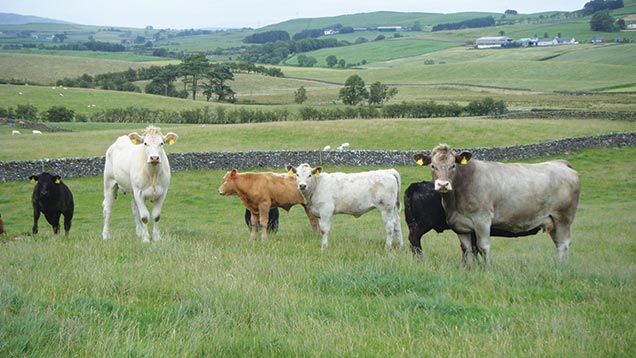New feed mix helps beef farmer slash feed costs

Growing a cheap protein source has drastically cut purchased winter feed costs and reduced fertiliser use at Killymingan Farm in Kirkgunzeon, Dumfriesshire.
Suckler producer Alan Crichton began trialling lupicaleage – a mix of lupins and triticale – in 2006 after being told access to his land would get more difficult, with colder, wetter summers and warmer, wetter winters predicted.
See also: Replacing wholecrop and barley with beta-maize saves farmer £120/head
Lupicaleage benefits
- Lupins are high in undegradable rumen protein
- The amino acid profile is better than soya
- This protein balances with starch from triticale as the stem is sugar rich
- Variable chop length – long straws promote cudding
- Saliva provides a natural buffer preventing acidosis
- Scratch factor and starch aid rumen development, improving growth rates
- Dung is firm and dry – no issues with dirty coats
- Cattle are calm and content
“I started on a small scale with 7ha and increased this to 40ha by 2014.
“Triticale does fine in dry conditions because of its deep-rooted rye parentage and lupins like the heavier wet soils. It just seemed to meet the requirements of the changing climate,” says Mr Crichton.
And with just a single cut taken anywhere between September and November, production costs have been reduced to about £18/t, down from £20/t when grass silage alone was produced.
The real saving, however, has been the drastic cut in purchased feeds, from 20t in 2013 to just 4t in 2014, to see him through the winter.
Another clear benefit is the reduction in nitrogen fertiliser application, which has been dramatically reduced by 90%, saving £6,000 last year.
This is due to the nitrogen-fixing properties of the lupins. Soil structure has also opened up, and undersowing with grass has resulted in the best catch crop Mr Crichton has ever seen.
Rations
Its high protein and energy values of around 13.5% crude protein and 11MJ of ME has meant Mr Crichton can feed lupicaleage to all livestock throughout winter.
Housed in early November to mid-May last winter, the herd of 130 mixed-breed cows, which include Simmental-cross, Limousin-cross and Angus-cross, were all fed using a tub mixer and weigh scale (see table).
|
Class of stock |
Winter ration a head |
|
Youngstock aged from 12 months |
20-25kg lupicaleage plus minerals |
|
Spring calvers |
30kg lupicaleage plus minerals until one week pre-calving, switched to ad-lib straw and 3lbs of mineralised high magnesium cake, followed by 40-45kg lupicaleage once calved |
|
Autumn calvers |
25kg lupicaleage, 20kg grass silage plus minerals |
Growth rates
Since feeding lupicaelage Mr Crichton says he has seen an improvement in the frame development of the animal.
The cows are run with Charolais, Simmental, Limousin and Angus bulls to calve in two batches, in the spring and autumn.
Steers are sold as forward stores at about 500kg aged 15 months, while heifers are either sold fat or as stores at 480kg.
Over the winter feeding period, the average daily liveweight gains are low at about 0.6-0.7kg/day. Mr Crichton believes this is important, however, to get a good frame size. Compensatory growth rates are then seen at turnout, averaging 1.4kg daily liveweight gain with no supplementary feed.
“They have a larger frame and are long-legged, which is very attractive to finishers. The animals fed grass silage were short and dumpy.”
Lupicaelage also has the scratch factor and starch needed for rumen development to increase growth rate , says farm adviser Chris Totten.
The crop is planted in the spring at a cost of £132/ha.
Standing 150ft above sea level, the farm has medium loam soils and receives an average of 52-54in of rain, says Mr Crichton, but this can vary considerably.
“It works well here because of the rainfall, but you have to have soils that can take it.”
However, Mr Crichton advises any farmers considering lupicaleage to start small as he says it’s not possible to grow it everywhere – it likes a pH of about 5.5.
The two crops look after each other, adds Mr Totten, as lupins alone are so uncompetitive they would be taken over by weeds. Triticale, however, supresses weeds and as it is a tall crop it brings the lupins up the canopy, creating a bulky crop.
As a result of this, lupicaleage has produced consistently high yields of 36-43t/ha at 30% DM with only a single cut. So Mr Crichton only requires one, or sometimes two cuts of grass silage, reducing the amount of travelling on his land, fuel and contractor costs.
Another advantage of lupicaleage is the extended time it can be harvested.
“It can have a two-month window, right up to November,” says Mr Crichton. “Protein levels remain good and ME only falls slightly and once it’s in the clamp it doesn’t go off.”
Lupicaleage production at Killymingan Farm
|
February |
12t/ha farm yard manure applied
|
|
April – May |
Contract ploughed |
|
May |
Sown at 144kg/ha (seed cost £132/ha), rolled and sprayed with herbicide (unless under-sown) |
|
June |
Sprayed with fungicide
|
|
September – November |
Harvested with a wholecrop header on a forage harvester. |
|
November – February |
Birds graze on seeds and stubble |

